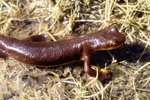
The term "salamander" refers to a collection of amphibian species that keep their tails as adults. Over 380 salamander species are known around the world, and these species vary in many ways. All salamanders go through a four-stage life cycle, from egg to larvae to juvenile to adult. In some species, juvenile salamanders have lungs. However, lungs are not present at the larvae stage of any salamander species.
The Amphibian Life Cycle
Salamanders are amphibians, meaning they live part of their lives in water and part of their lives on land. Adult salamanders lay their eggs in water, and these eggs hatch into a larval form that uses gills to breathe underwater. Most amphibian larvae have tails, which are lost during the transition to juvenile or adult; only salamanders keep their tails through maturity. When the larvae change into juveniles, they begin to look similar to their adult versions. In frogs, for example, juveniles begin breathing through lungs and developing legs. The changes between the larval, juvenile and adult stages of salamanders' lives vary by species. However, all of them have gills during the larval stage.
Salamanders with Lungs
In some salamander species, juveniles lose their gills and develop lungs. The blue-spotted salamander is one example. These salamanders attach their egg masses to twigs or plants that lie in water so when their larvae hatch they are in the water. The larvae have visible gills on the outside of their bodies. When they become juveniles, however, they lose their fins and gills (both are absorbed into their bodies) and they begin to breathe through their lungs. At this point, the juveniles leave the water and begin living on land.
Salamanders with Gills
Few salamander species retain their gills into maturity. One such species is the Mexican axolotl, found only in a single lake near Mexico City. These salamanders have unusual feathery, pink gills that are not only visible but stand out from their heads. Additionally, the axolotl keeps its fin so it can continue to swim in the water, which they do permanently.
Other Salamander Options
Salamander respiration covers a wide-range of possibilities, including species that do not have lungs or gills, as well as salamanders who have both. The family known as lungless salamanders (scientifically named Plethodontidae) has no lungs. Instead, they breathe through their skin as well as specially designed membranes in their throat and mouth. To survive, these salamanders must keep those parts of their body constantly moist. Cave-dwelling olms, on the other hand, have lungs and gills when they reach maturity even though they live entirely aquatic lives in total darkness. Other salamanders, such as the hellbender, have lungs but still breathe through their skin pores.
References
- San Diego Zoo: Salamander & Newt
- Montgomery County: About Salamanders
- Purdue University: Help the Hellbender
- London Zoo: Life Cycle of Amphibians
- Michigan Department of Natural Resources: Salamanders
- National Geographic: Mexican Axolotl
- Encyclopedia Britannica: Lungless Salamanders
- Google Books: Newts & Salamanders
- PBS: 12 Facts About Hellbender Salamanders
Photo Credits
-
Hemera Technologies/PhotoObjects.net/Getty Images
Writer Bio
Amy Jorgensen has ghostwritten more than 100 articles and books on raising and training animals. She is also an amateur dog trainer. She has also written more than 200 blog posts, articles, and ebooks on wedding and party planning on behalf of professionals in the field.


